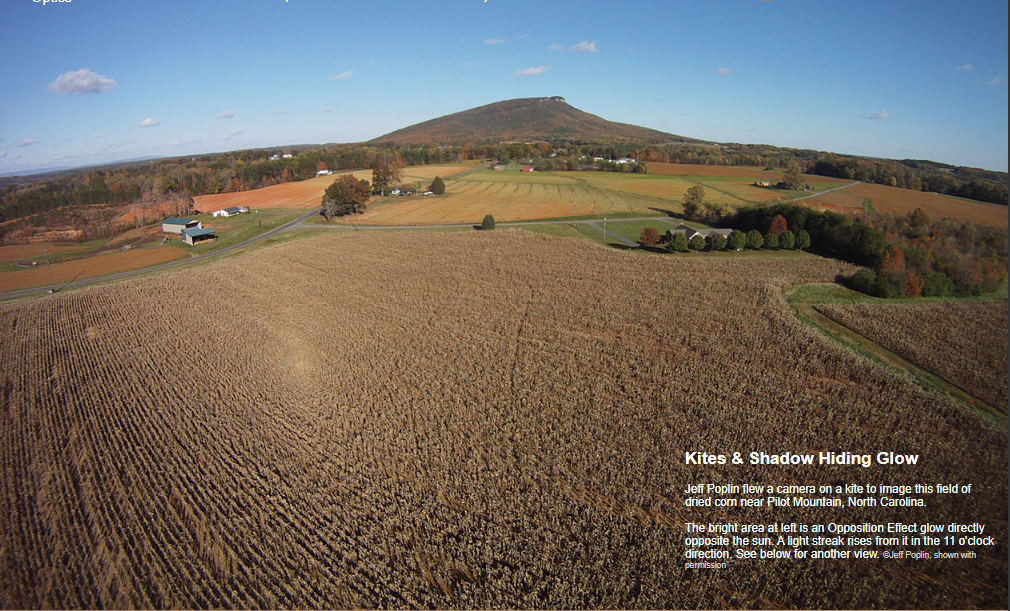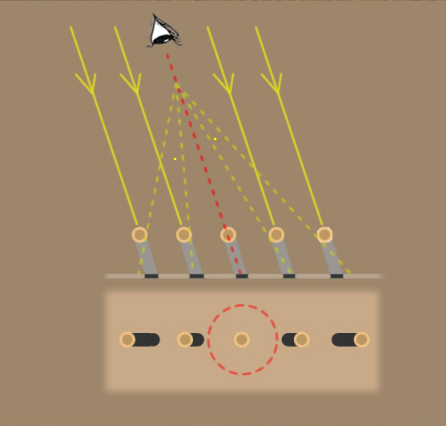OPOD - Kites & Opposition Effect
OPOD - Kites & Opposition Effect: Unveiling the Secrets of Shadow Hiding Glow
Have you ever wondered about the mysterious glow that sometimes appears opposite the sun? Well, Jeff Poplin took to the skies with a camera attached to a kite and captured a fascinating image that sheds light on this phenomenon. The photograph showcases a field of dried corn near Pilot Mountain, North Carolina, where a bright area on the left side of the image reveals an Opposition Effect glow. But what exactly causes this intriguing glow?
The answer lies in the concept of shadow hiding. As the sun illuminates the corn shoots, they cast shadows on the soil beneath them. However, when we look in the direction directly opposite the sun, these shadows are cleverly concealed beneath the bright sunlit corn itself. As we shift our gaze away from the antisolar point, the shadows gradually become more visible. Consequently, the area around the antisolar point appears brighter because there are fewer shadows compared to its surroundings.
Interestingly, the bright streak at the 11 o'clock direction in the image is a result of shadow asymmetry caused by the tall corn stems aligning in a similar direction. This alignment creates variations in shadow length and intensity, further enhancing the visual effect. Such shadow hiding is an integral part of what is known as the 'Opposition Effect'.
The term 'Opposition Effect' originated from observations of Mars and the Moon, which appear brighter when they are positioned opposite the sun (at opposition). Shadow hiding plays a role in their increased brightness, along with other factors such as retro-reflection by rock minerals and a phenomenon called coherent backscattering.
Shadow hiding is a subtle phenomenon that is best observed visually when walking or gently swaying your head. By moving your head from side to side, you can perceive small contrast differences more effectively. If you find yourself aboard an aircraft, keep an eye out for a mesmerizing glow drifting across the landscape.
It's worth noting that this article has been automatically converted from the old site and may not appear as intended. However, the original article can be found here.
Now that we've explored the basics of the Opposition Effect and shadow hiding, let's delve deeper into this captivating atmospheric optics phenomenon:
The Science Behind Shadow Hiding
- Shadow hiding occurs when shadows cast by objects are obscured by the objects themselves when viewed from a specific angle.
- When observing from the antisolar point (directly opposite the sun), the shadows are hidden beneath the brightly illuminated objects.
- As we move away from the antisolar point, the shadows become more visible, resulting in a perceived increase in brightness in the antisolar region.
- Shadow hiding is not limited to cornfields; it can occur in various landscapes and environments where objects cast shadows on their surroundings.
Factors Contributing to the Opposition Effect
The Opposition Effect is a complex phenomenon influenced by several factors:
- Shadow Hiding: As discussed earlier, shadow hiding plays a crucial role in creating the opposition glow.
- Retro-Reflection: Retro-reflection occurs when light is reflected back towards its source. In the case of Mars and the Moon, certain rock minerals exhibit retro-reflection, adding to their increased brightness during opposition.
- Coherent Backscattering: Coherent backscattering refers to the scattering of light in a specific direction due to interference effects. This phenomenon contributes to the enhanced brightness observed during opposition.
Observing the Opposition Effect
While Jeff Poplin's aerial photograph provides a stunning view of the Opposition Effect, there are other ways to witness this phenomenon:
- Visual Observations: Walking or gently swaying your head while observing an area opposite the sun can reveal subtle variations in brightness caused by shadow hiding.
- Aerial Perspectives: If you find yourself aboard an aircraft, keep an eye out for a mesmerizing glow drifting across the landscape. The elevated vantage point can offer a unique view of the Opposition Effect.
The Beauty of Atmospheric Optics
The world of atmospheric optics never ceases to amaze with its captivating displays. From shimmering rainbows to glowing halos, these natural phenomena provide us with a glimpse into the wonders of light and its interaction with the atmosphere.
The Opposition Effect, with its intriguing shadow hiding glow, adds yet another dimension to our understanding of atmospheric optics. By unraveling the science behind this phenomenon and exploring its various manifestations, we gain a deeper appreciation for the complexities of our natural world.
So, the next time you find yourself gazing at a field of corn or witnessing a celestial opposition, take a moment to marvel at the hidden beauty that lies within the interplay of light, shadows, and our atmosphere.

Kites & Shadow Hiding Glow
Jeff Poplin flew a camera on a kite to image this field of dried corn near Pilot Mountain, North Carolina.
The bright area at left is an Opposition Effect glow directly opposite the sun. A light streak rises from it in the 11 o'clock direction. See below for another view. ©Jeff Poplin, shown with permission

The ‘glow’ is caused by shadow hiding.
The dry corn shoots cast shadows on the soil. When looking in the direction exactly opposite the sun these shadows are hidden beneath the bright sunlit corn itself. As you view further and further from the antisolar point the shadows become more and more visible. The antisolar point area therefore looks brighter because compared with its surroundings there are fewer shadows. The 11 o’clock bright streak is the result of shadow asymmetry caused by the tall stems all aligned in more or less the same direction.
Shadow hiding is part of the ‘Opposition effect’. The name arose from the extra brightness of Mars and the Moon when opposite the sun - at opposition. Shadow hiding by Martian and Lunar soils does contribute to their brightening but so do retro-reflection by rock minerals and an effect called coherent backscattering.
Shadow hiding is subtle. It is best seen visually when walking or swaying the head. Small contrast differences are better seen when moving the head from side to side. Look for it also from an aircraft as a glow drifting across the landscape.

Note: this article has been automatically converted from the old site and may not appear as intended. You can find the original article here.
Reference Atmospheric Optics
If you use any of the definitions, information, or data presented on Atmospheric Optics, please copy the link or reference below to properly credit us as the reference source. Thank you!
-
<a href="https://atoptics.co.uk/blog/opod-kites-opposition-effect/">OPOD - Kites & Opposition Effect</a>
-
"OPOD - Kites & Opposition Effect". Atmospheric Optics. Accessed on December 22, 2024. https://atoptics.co.uk/blog/opod-kites-opposition-effect/.
-
"OPOD - Kites & Opposition Effect". Atmospheric Optics, https://atoptics.co.uk/blog/opod-kites-opposition-effect/. Accessed 22 December, 2024
-
OPOD - Kites & Opposition Effect. Atmospheric Optics. Retrieved from https://atoptics.co.uk/blog/opod-kites-opposition-effect/.